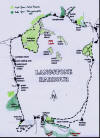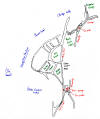

Langstone Harbour is the middle of three important natural harbours and lies between Portsea and Hayling Islands with around 25km of shore line. It is part of a the Solent area Special Area of Conservation and has international and UK designations mainly for its bird life. In the winter there are thousands of Geese, ducks and waders of which the Brent geese are maybe the most noteworthy. In the summer gulls, terns and lapwings breed plus numerous small perching birds. In the migration seasons there are lots of extras including ospreys and usually quite a few rarities. The harbour is thus a Mecca for bird watchers from a wide area of southern England.
Plant and insect life is also well represented around the harbour with orchids in marshy places and many other attractive flowers. These attract butterflies, moths and other insects. Adders are present for example at the oyster beds.
There is a way-marked path round the harbour which is well marked. See the picture right. There are also interpretation notice boards at key locations along the walk.
The Harbour Site of special Scientific Interest embraces the following Nature Reserves. A map showing the rough locations of the reserves is shown below.
The Kench Managed by Hampshire CC who also manage the Billy Trail
The oyster beds. Managed by Havant BC and RSPB.
Southmoor Managed by Hampshire & I of W Wildlife Trust but now becoming saltmarsh following a breach in the sea wall
The RSPB Islands. Managed - obviously - by the RSPB
Farlington marshes Managed by Hampshire & I of W Wildlife Trust.
Milton Locks Managed by Hampshire & I of W Wildlife Trust.
 Click on the map to see it full size.
Click on the map to see it full size.
This shallow tidal inlet alongside Ferry Road on Hayling Island (Map reference SZ692994) is used by many birds as a feeding area while the tide is out and when it is high the shingle ridge between the inlet and the main harbour is used as a roost by waders. It's important not to disturb this roost area while the birds are using it. Most of the birds can be identified from the road. The path down the eastern edge and the copse alongside are worth investigating for wild flowers and passerines, including migrant warblers, but the copse may be reduced by pending development of the Sinah Warren Hotel complex.
The RSPB Islands
The RSPB look after a group of islands off the east side of Farlington Marshes and the surrounding areas of mud. The islands provide high tide roosts for waders, rest areas for wildfowl and homes for breeding gulls and terns including little terns. The breeding birds suffer predation by gulls, foxes and kestrels in spite of the measures taken by the RSPB to deter them.
There is a landing area on the south of Long Island, but I suggest it is better not to make use of this and leave the birds in peace - particularly in the breeding season. The birds can be seen from the eastern edge of Farlington Marshes - although you will really need a good telescope to see them well.
Look out for peregrine and merlin resting on the posts or notice boards on the islands.
The 350 acres of this nature Reserve extend out into the harbour and provide excellent view points to watch the life of the harbour.
 The marshes
have a range of habitats including bushes, ditches, shorter grasslands and the
lake, the deeps and other small pools of water. The reserve is managed by the
Hampshire & IoW Wildlife Trust. It was their first reserve in 1961 after a
group of enthusiasts worked to get the marshes looked after for wildlife.
(Click on the map to see it full size)
The marshes
have a range of habitats including bushes, ditches, shorter grasslands and the
lake, the deeps and other small pools of water. The reserve is managed by the
Hampshire & IoW Wildlife Trust. It was their first reserve in 1961 after a
group of enthusiasts worked to get the marshes looked after for wildlife.
(Click on the map to see it full size)
The marsh is a significant example of once common coastal grazing marsh. A local farmer provides cattle which keep the grass sward just about right for the birds that breed in the summer. In the winter waders and wildfowl feed or rest on the grass.
The Lake and the Deeps (see map) attract ducks and waders and it is principally on these pools that rare birds are likely to turn up - especially at migration times. But the bushes hold breeding birds e.g. whitethroats in the summer and can also throw up some nice surprises - especially at migration times. The reed beds are home to warblers (reed and sedge) in the summer and also bearded tits throughout the year.
Over 300 species of wildflowers and grasses exist on the marsh including rarities like sea barley and slender hares ear. Marsh orchids grow well in the north east corner of the reserve
Invertebrates, including some scarce spider species, live in the grassy areas.
Many local people make good use of the sea wall path to enjoy the open space especially on sunny week ends. Dogs are OK but must be kept on leads. Cycling on the reserve is not allowed.
Southmoor
This area can be reached from Mill Lane in Langstone or from Southmoor Lane in Bedhampton. The paths that used to facilitate walking across the 'moor' have now been inundated daily at high tide and the once grazing marsh has become saltmarsh. As saltmarsh it is still worth a visit as birds now regularly use it and it has good views over the north east corner of Langstone Harbour. Expect waders and wildfowl in the winter, warblers in the summer and occasionally owls.
 Click on this map to see it full size.
Click on this map to see it full size.
The old oyster beds in the north east corner of the Harbour (SU715035) and some of the surrounding mud is a local nature reserve with the bird life being its major attraction.
Access is by a track off the Havant Road by the 'Esso' garage and leading to the shore. There is plenty of car-parking available here except when the tide is high and wind attracts surf boarders. There is an alternative car-park shown on the map off the Havant Road just south of the Langstone Bridge.
The overflow car-park immediately behind the Esso garage has a fine display of goats beard in June/July.
By following the shore to the north from the southern car-park you come to a saline lagoon which holds water at all states of the tide and attracts breeding terns and gulls in the summer and ducks in the winter. Waders can be watched all round the shore with good high tide roosts viewable with a telescope. The bushy area holds some good plants (centaury, dame's violet etc,), attracts butterflies and there are adders on the edges of the scrub.
Offshore a telescope will help you find the wintering grebes and ducks that are a feature here between October and March.
In the summer please do not allow dogs to swim in the lagoons.
Milton Locks NR
This small two acre reserve on the shore of Eastney Lake in the SW corner of the harbour is the last remnant of natural shore line on the Portsmouth side of the harbour. It consists of grassland with scrub and some trees. It not in great condition but recent efforts by the Wildlife Trust and the Friends of Langstone Harbour may be making a difference.
There are some wild flowers and the grassland and some nettles attract butterflies.
Access is best from the car-park of the 'Thatched House' pub at the end of Locksway Road.
Milton Common, a short way north and between the Eastern Rd and the shore is well worth a look in the summer for warblers and wild flowers. Cetti's warblers breed in the reed beds. It can also be accessed from Moorings Way.